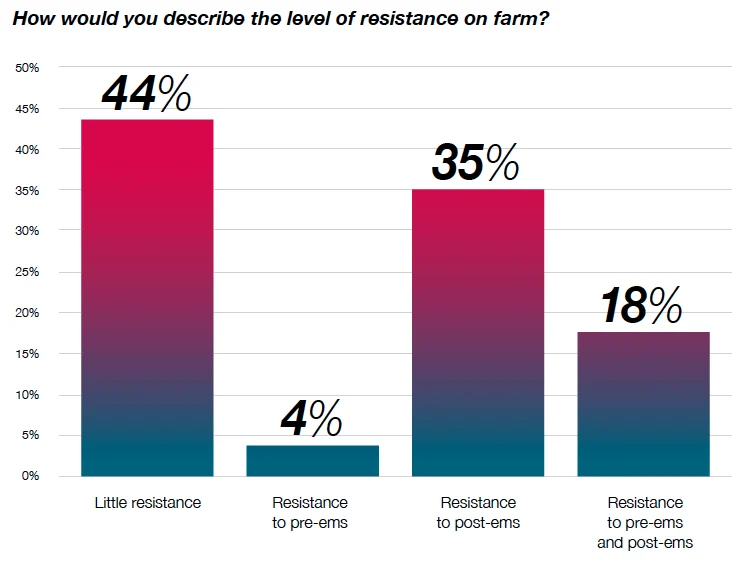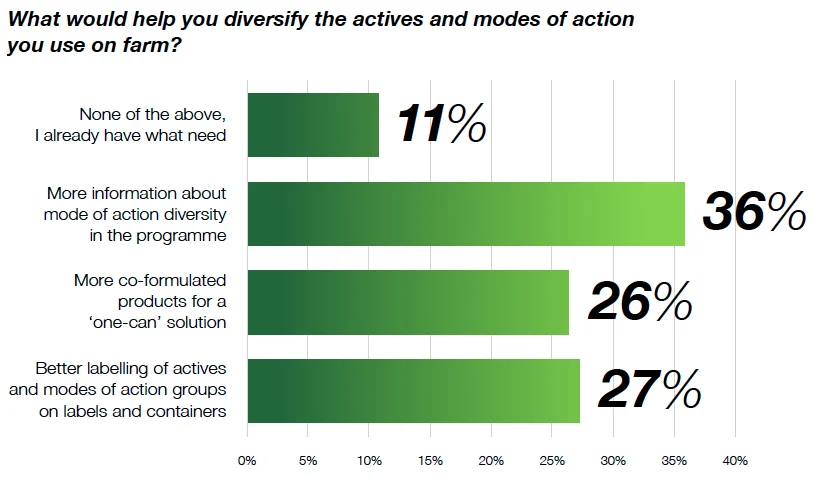
The Bayer Mode of Action Survey 2023 identified that resistance management is a high priority to most farmers. 98% of 243 participants say is it very important or fairly important to agronomy on farm. With no herbicide completely safe from the spectre of resistance, what practical steps can farmers take to maintain herbicide efficacy?
Author
| 22nd August 2023Tags
Resistance management into practice
How real is the danger?
As a rule, pre-emergence herbicides are less prone to resistance than contact-acting chemistry, this is borne out by the survey results which show far more farmers reporting post-em resistance than pre-em. But resistance to some pre-em active is already a problem particularly in Italian ryegrass. Critically, resistance tends to be a ‘one-way street’, it doesn’t go away so prevention is really the only cure.

Think cultural
Resistance management starts with cultural techniques. Controlling weeds without chemistry means you cannot be selecting for herbicide resistance. There is a familiar menu of cultural controls: delayed drilling, spring crops, rotational ploughing, higher seed rates, crop rotation and so on.
The most important thing is to stack different controls together and have some variation over the seasons. Having the same approach year-in-year out increases the risk of selecting for weeds whose life-cycle fits the system. A pertinent example of this is meadow and rye brome which are enjoying a resurgence as they are well suited to low-tillage systems.
“Having a good set of cultural controls is really the baseline for weed control. In the 2010’s everyone adapted to managing black-grass without relying on Atlantis and it underlined that cultural techniques work. I think we are generally in a good place and most of us understand what is needed but that doesn’t mean doing it is simple.” Says Bayer’s Darren Adkins.
Eliminate as many weeds as possible before the crop is sown, this can be through cultivation, glyphosate or most probably a combination of the two. Give selective herbicides as little work to do as possible.
We Highly Recommend:
Use different modes of action
Farmers dealing with black-grass and Italian ryegrass have long known the benefit of stacking and sequencing different actives for autumn weed control. Each additional active improves efficacy but also helps prevent resistance, but it is worth checking the mode of action too.
The mode of action is the molecular basis for how a herbicide kills a weed. For example, prosulfocarb, tri-allate, flufenacet and ethofumesate all inhibit cells from making very long-chain fatty acids, disrupting cell division so they are placed in the same HRAC Mode of Action Group.
“Try to use actives from different groups. At pre-em, Group 15 is the main one to watch. Be sensible and make sure there is enough diversity. For example, Liberator (flufenacet + diflufenican) + Proclus (aclonifen) + Defy (prosulfocarb) is a good mix for efficacy and has three modes of action.”
More on HRAC
The Herbicide Resistance Action Committee is a worldwide initiative to share information on herbicide efficacy and resistance. It has classified all actives into numbered groups, for pre-em grass-weed control there are actives from 6 groups (3, 5, 12, 15, 30, 32). The recent Mode of Action Survey showed that many farmers would like a bit more information about this.


Making use of the HRAC Groups should now be much easier because all labels should clearly show the group of every active in the product, see the example from Alternator Met. HRAC has also provided guidance on safe use of Group 15 actives which are widely used in cereals. It is thought actives in Group 15 exhibit multi-site or at least multi-enzyme mode of action, consequently programmes containing more than just a Group 15 active are still supported by HRAC.

Overall, the HRAC system provides a useful tool to quickly check how diverse your programme is. In one season, having diversity is quite straightforward but when you look across the rotation over several years, it can help to show resistance risks. For example, pendimethalin and propyzamide are both in Group 3 (inhibition of microtubule assembly) so if beans and oilseed rape feature heavily in the rotation then perhaps alternatives to pendimethalin might be better in wheat.
How are farmers protecting different modes of action?
When asked, every farmer was taking at least one of the steps in the graph below to protect modes of action. Most important is rotating actives. The recent additions, aclonifen and cinmethylin have definitely improved control and can be used in separate programmes with no crossover. That means you can rotate between the two, add in non-cereal break crops and suddenly maintaining efficacy long-term looks very achievable.
Monitoring performance also helps, the main thing is to understand any perceived drop in control. Application technique and soil conditions both have a big influence on efficacy. Rule these out before ripping up the programme because of resistance.